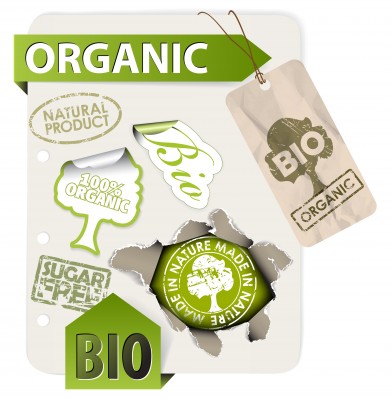Understanding Food Claims- The Good, The Bad, & The Organic
 Food labels can be deceptive.
Food labels can be deceptive.
Many, if not most food packages make some kind of claim about their product such as, “low-this,” “good source of…,” and “all natural,” “Organic.” But what do these things really mean? In reality, these are advertisements to convince you to buy the product and may not really give an accurate indication of how healthful a food really is. Here is a list of common advertisements on packages and what they really mean.
The Not so Good Stuff:
- “Natural” or “All Natural”- This really doesn’t mean anything. In order for a food to list this on the package, it simply has to have at least one ingredient that came from a natural source. This doesn’t mean that the ingredient wasn’t processed and is nothing like it’s natural source any more. And it doesn’t mean the food is Organic or Free Range or un-processed in any way.
- “No Artificial Flavors”- All this means is that the artificial flavors that they produced in a laboratory are supposed to mimic real flavors found in nature, and are not new unique flavors not found in nature. Still completely artificial.
- “Good Source of…” - In order for this to be used on food packages, the food only has to contain 10% of the Daily Value of whatever nutrient they are talking about. Not very substantial in reality…
- “0 Grams Trans Fat” or “Trans Fat Free” - This doesn’t mean that the food actually has NO trans fat, it means that the food has less than 0.5 grams of trans fat per serving. If you eat more than 1 serving, you are easily adding up to a substantial amount of artery clogging trans fat.
- “Cage Free Chicken or Eggs” - All this means is that the chickens weren’t in cages. It doesn’t mean they are healthy, raised in a humane way, or even ever saw the light of day for their entire lives. Better to choose Free Range or Pasture Raised chicken and eggs.
- “Made with Real Fruit” - This only means that the food has at least one ingredient that was derived from fruit. The product doesn’t necessarily contain any real fruit at all. Select a fresh product that only lists pure fruit juice as the ingredient.
- “No MSG” - For a food to be labeled as having “No MSG”, it cannot say “monosodium glutamate” on the ingredients list, but there are many other laboratory produced compounds that contain MSG that can still be in the food including “natural flavors”, hydrolyzed vegetable protein, autolyzed yeast, hydrolyzed yeast, yeast extract, soy extracts, and protein isolate. With lots of controversy about the safety of these types of additives, it’s safest to stick with whole plant foods and pasture raised animal foods.
- “Zero Sugar or Sugar Free” - Yes, this means that a food doesn’t contain sugar, but it likely contains laboratory created artificial sweeteners. Health effects of these are controversial.
- “Made with Whole Grains” - This means that the product has some amount of whole grains, but it might be way down on the ingredients list and have processed flour as a primary ingredient. Be sure to select a food that lists Whole… as the first ingredient.
- Health Claims: “Lowers Cholesterol, Heart Healthy, Etc.” - While there are some regulations about when these health related statements can be made, and some products really are good, they often have little scientific backing and shouldn’t be a real reason to buy. Be sure to use your best judgement.
The Good Stuff:
- “Organic” - For a food to be labeled as Organic it must meet certain strict requirements. It cannot use any synthetic chemical pesticides, fertilizers, or hormones in production, no irradiation, industrial solvents, chemical food additives, and cannot be genetically modified. For Organic Meat, dairy, and eggs, the animals are only fed organic feeds. This doesn’t necessarily mean the animals were Free Range or treated humanely. If a label says “Made with Organic…” it probably contains some non-organic ingredients too.
- “No Antibiotics” - This doesn’t mean Organic, but does mean that the animal had n0 antibiotics for it’s entire life.
- “Hormone Free or Natural Chicken or Pork” - In the US it is actually illegal for producers to use hormones in chicken or pork, so this isn’t any more healthy and doesn’t mean it’s Organic or Free Range.
- “No Artificial Hormones” - For eggs, beef, and milk, this means exactly what it says, that the animals were not given artificial hormones. It doesn’t mean that the animals weren’t given extra natural hormones to cause them to produce un-natural amounts of milk, eggs and meat…
- “Free Range or Pasture Raised” - There are currently no official regulations for what the definition of these terms are, but in general, it means that the animals had access to the outdoors and the ability to exercise and forage for foods that are their natural diet.
- “Grass Fed” - There are some regulations about the term grass fed and in general, it indicates that the animal has been fed primarily by pasture grass and is fed very little, or no other feed at all.
With all of the confusing and sometimes misleading food labels, the key is actually reading the ingredients list so you can know for sure what’s in the food. Look for foods that have as short a list as possible, have ingredients that you know what they are, or is a fresh food that doesn’t have any added ingredients.
Choosing whole foods can go a long way to promoting health and maintaining a healthy weight and avoiding lifestyle related conditions. The less processed and natural foods are, generally, the better they are for us to eat. Make nutrition and whole foods a foundation to your wellness routine.
Browse our Merchant Directory to include the assistance of a Nutrition expert, Personal Trainer, Holistic Health Services, Lifestyle Coach, or to find Healthy Food options.
Sources: Michael Pollan In Defense of Food, FDA.gov
Author: Tony Montijo, BS Kinesiology, CPT, CES






